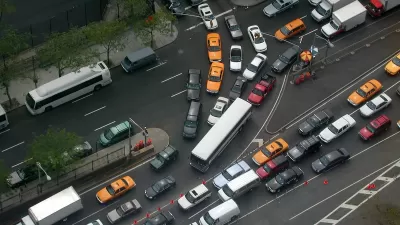The Scandinavian country is a pioneer when it comes to EV adoption, but there are downsides.

In a piece for Vox, David Zipper describes how the push to promote electric vehicles in Norway is contributing to the famously egalitarian country’s inequality and stymying efforts to reduce car dependency. “Despite the hosannas from abroad, Norway’s government has begun to unwind some of its electrification subsidies in order to mitigate the downsides of no-holds-barred EV promotion.”
Environmental and transportation advocates have noted that switching fossil-fuel powered cars for electric ones is not enough. To limit the impacts of climate change, we must reduce vehicle miles driven overall. But in Norway, where the government has heavily invested in EV subsidies and roads, cars have become indispensable for many residents—but not all. “In Bergen, for instance, 67 percent of households in the lowest income quartile go without [a car].”
Meanwhile, “The effect of EV adoption on public transportation has been a particular concern for Norway’s cities because boosting transit ridership has been a linchpin of local mobility strategies.” According to Zipper, “EV promotions have shrunk the funding available to invest in transit improvements because Norwegian public transportation budgets are partly funded through the road tolls that the national government exempted EV owners from paying.”
Norway offers a valuable lesson for other countries and cities: while EVs can help decarbonize the transportation industry, “an influx of electric vehicles can hinder efforts to escape the automobile’s urban stranglehold.”
FULL STORY: Why Norway — the poster child for electric cars — is having second thoughts

Alabama: Trump Terminates Settlements for Black Communities Harmed By Raw Sewage
Trump deemed the landmark civil rights agreement “illegal DEI and environmental justice policy.”

Planetizen Federal Action Tracker
A weekly monitor of how Trump’s orders and actions are impacting planners and planning in America.

The 120 Year Old Tiny Home Villages That Sheltered San Francisco’s Earthquake Refugees
More than a century ago, San Francisco mobilized to house thousands of residents displaced by the 1906 earthquake. Could their strategy offer a model for the present?

In Both Crashes and Crime, Public Transportation is Far Safer than Driving
Contrary to popular assumptions, public transportation has far lower crash and crime rates than automobile travel. For safer communities, improve and encourage transit travel.

Report: Zoning Reforms Should Complement Nashville’s Ambitious Transit Plan
Without reform, restrictive zoning codes will limit the impact of the city’s planned transit expansion and could exclude some of the residents who depend on transit the most.

Judge Orders Release of Frozen IRA, IIJA Funding
The decision is a victory for environmental groups who charged that freezing funds for critical infrastructure and disaster response programs caused “real and irreparable harm” to communities.
Urban Design for Planners 1: Software Tools
This six-course series explores essential urban design concepts using open source software and equips planners with the tools they need to participate fully in the urban design process.
Planning for Universal Design
Learn the tools for implementing Universal Design in planning regulations.
Clanton & Associates, Inc.
Jessamine County Fiscal Court
Institute for Housing and Urban Development Studies (IHS)
City of Grandview
Harvard GSD Executive Education
Toledo-Lucas County Plan Commissions
Salt Lake City
NYU Wagner Graduate School of Public Service





























